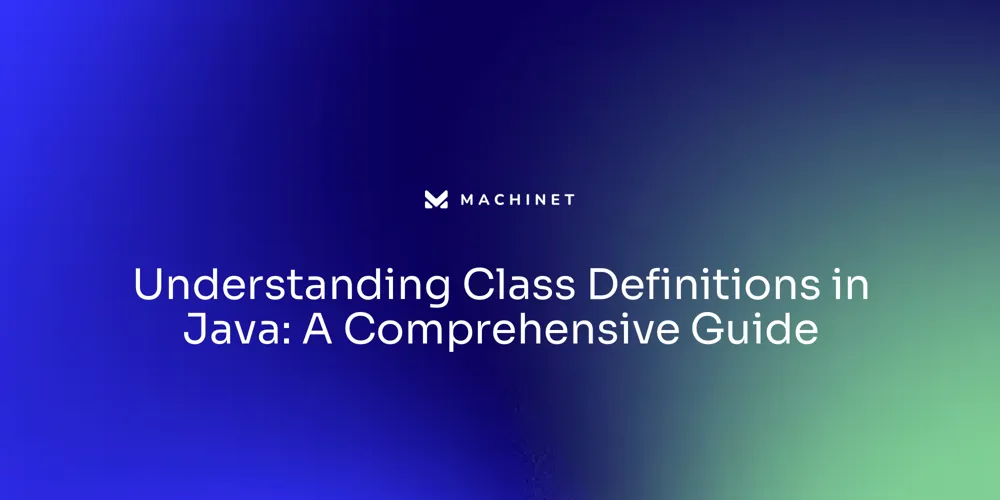
Table of Contents
- What is a Class in Java?
- Declaring a Class in Java
- Class Members
- Access Modifiers and Encapsulation
Introduction
In Java, the concept of a class is foundational, acting as a blueprint for creating objects. These objects are known as instances of their respective classes and embody both state and behavior.
But what exactly is a class in Java? How do you declare a class?
And what are the different class members that can be defined? In this article, we will explore these questions and delve into the importance of understanding classes in Java. By the end, you'll have a clear understanding of how classes work and their significance in Java programming. So let's dive in and unlock the power of classes in Java!
What is a Class in Java?
In Java, the concept of a class is foundational, acting as a blueprint for creating objects. These objects are known as instances of their respective classes and embody both state and behavior. Attributes within a class represent the state of an object, such as a car's color, model, and speed.
These attributes are essentially properties that define the characteristics of an object. On the other hand, methods encapsulate the behavior, detailing how an object can interact with its environment or with other objects. For instance, a Car class might include methods like start Engine(), stop Engine(), and brake(), each defining an action the car can perform.
To illustrate, consider a simple command-line application for a parking lot system. The application's structure is determined by classes that represent different aspects of the parking lot, such as vehicles, parking spaces, and a payment system. Each class contains attributes relevant to its role and methods that dictate how it functions within the application.
For example, a Vehicle class might have attributes for license plate numbers and vehicle size, along with methods to check in and out of the parking lot. This object-oriented approach to designing Java applications promotes clean, modular, and reusable code. Recent advancements in Java, such as the introduction of pattern matching and the consideration of unnamed classes in JDK 22, showcase Java's ongoing evolution to enhance code readability and maintainability.
These features reflect the language's commitment to enabling developers to write expressive and concise code. As noted in industry insights, Java remains a versatile tool, often used alongside other popular languages and technologies such as JavaScript, SQL, Python, and HTML/CSS. Understanding the interplay between classes, attributes, and methods is crucial for developers to master Java and contribute to the creation of robust, efficient software applications.
Declaring a Class in Java
In Java, the art of class declaration is a fundamental skill, akin to laying the foundation for a building. When you declare a class with the 'public class MyClass' syntax, you're using the 'class' keyword to signal to the Java compiler that a new blueprint for objects is being created. The name 'MyClass' adheres to the CamelCase convention, starting with an uppercase letter, thus establishing good coding practices from the outset.
Recent developments in Java, particularly with JDK 21's preview language feature and its continued evolution in JDK 22, have introduced intriguing changes. These include the proposal for Unnamed Classes and Instance main Methods. The shift towards a simpler approach where a source file without an enclosing class declaration now implicitly declares a class is a significant departure from the static context where a main method was traditionally required to be static.
Now, the main method can be an instance main method, executable by creating an instance of a class and invoking main() on it. This evolution simplifies the launch protocol for Java applications, making it more accessible for new developers. It allows for greater flexibility in code organization and execution, aligning with the dynamic nature of Java's ecosystem.
With JDK 22, the adoption rates are indicative of the community's receptiveness to such enhancements. The New Relic data shows a substantial increase in the use of newer Java versions, with Java 17's adoption growing nearly 300% within a year, a stark contrast to the slower adoption of Java 11. The ability to declare classes and understand their invocation context is crucial.
Instance methods, for example, can only be called on an object's instance and are declared without the static keyword, emphasizing the object-oriented nature of Java. The use of the 'this' keyword within instance methods distinguishes instance variables from parameters with the same name, providing clarity within the code. In summary, the declaration of a class in Java is more than a mere formality; it's a statement of structure and intent, aligning with Java's object-oriented paradigm and adapting to its evolving features.
Class Members
In Java, a class serves as a blueprint for objects, encapsulating attributes and methods that define their state and behavior. Fields in a class represent the object's state, akin to properties that hold data.
Methods, akin to functions within a class's scope, dictate the object's behavior, enabling interactions and operations. Constructors, a special kind of method, are tasked with initializing new objects, setting the stage for their use.
Nested classes, which are classes defined within another class, offer a structured way to handle complex coding scenarios. For instance, pattern matching in Java allows for matching values against patterns with variables and conditions.
When a match is found, parts of the value are bound to these variables, leading to more readable and intuitive code. Classes can be marked as 'sealed' to restrict which other classes may extend them, providing a more controlled form of inheritance.
Recent advancements in Java, such as the introduction of record patterns and pattern matching for switch statements in Java 20, have further enhanced the language's syntax and semantics. These features aim to simplify the development and maintenance of complex data structures and concurrent applications. The use of meaningful variable names within classes and methods greatly improves readability, maintainability, and collaboration. Clean Java code is not just functionally correct but also easy to understand and modify, which is essential given that code is often read more frequently than written. This practice of writing clean, understandable code is vital in a world where Java remains one of the most widely used programming languages.
Access Modifiers and Encapsulation
In Java, the elegance of code is often encapsulated within the constructs of its syntax and semantics. Access modifiers like 'public', 'private', and 'protected' are not merely tools to adjust visibility; they are the very essence of encapsulation, a principle that safeguards the internal complexities of a class while presenting a clear interface to the rest of the application.
The benefits of this approach are manifold; clean code is not only a delight to work with but also accelerates development by making the codebase more intuitive and easier to navigate. A staggering 91% of Java applications that report to New Relic leverage logging frameworks, showcasing the importance of maintaining efficient and readable code for troubleshooting and performance.
Furthermore, the evolution of Java is marked by the introduction of pattern matching and sealed classes, which streamline the processing of data structures and enforce a more rigid type hierarchy respectively. Java's journey from version 8 through to version 21 has been shaped by over 232 JDK Enhancement Proposals (JEPs), each refining the platform to better meet the needs of developers and applications alike. These enhancements, such as the recent updates to virtual threads in Java 20, exemplify Java's commitment to aiding developers in writing code that is not only clean and maintainable but also robust and future-proof. As the language continues to evolve with new features and improvements, the philosophy of writing clean, efficient, and organized Java code remains a cornerstone for developers aiming for high-quality software solutions.
Conclusion
In conclusion, understanding classes in Java is crucial for developers as they serve as blueprints for creating objects and encapsulate both state and behavior. Classes define the attributes that represent the state of an object and the methods that determine its behavior.
By declaring a class, developers establish the structure and intent of their code. Recent advancements in Java, such as pattern matching and the consideration of unnamed classes in JDK 22, reflect the language's commitment to enhancing code readability and maintainability.
These features simplify code organization and execution, making Java more accessible to new developers. The ability to declare classes and understand their invocation context is essential for leveraging Java's object-oriented nature effectively.
Class members, including fields, methods, constructors, and nested classes, offer a structured way to handle complex coding scenarios. Meaningful variable names within classes and methods improve code readability, maintainability, and collaboration.
Writing clean and understandable code is vital given that Java remains one of the most widely used programming languages. Access modifiers like 'public', 'private', and 'protected' play a crucial role in encapsulation, safeguarding the internal complexities of a class while providing a clear interface to the rest of the application. Clean code not only accelerates development but also aids troubleshooting and performance analysis. As Java continues to evolve with new features and improvements, writing clean, efficient, and organized Java code remains essential for developers aiming for high-quality software solutions. By mastering classes in Java, developers unlock the power to create robust, efficient applications that meet the needs of users in an ever-changing technological landscape.
Start writing clean and understandable code with Machinet today!
AI agent for developers
Boost your productivity with Mate. Easily connect your project, generate code, and debug smarter - all powered by AI.
Do you want to solve problems like this faster? Download Mate for free now.




